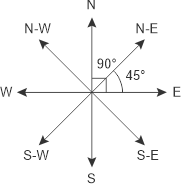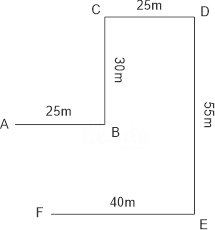Are you looking for any of these?
- Direction Sense Questions
- Direction Sense Questions and Answers
- Direction Sense for CET
- Direction Sense Tricks and Tips
- New Pattern Direction Questions PDF
- New Pattern Direction Quiz PDF
- Coded Direction and Distance Questions PDF
- Directions Problems with Solutions
- Direction and Distance Reasoning Questions PDF
- Direction Sense for Bank PO with Solution PDF
- Direction Sense PDF
If your answer is yes, then you have come exactly where you should have been. We will provide you the PDF to help you clear your basics and get you this topic right.
The Questions on Direction sense test are designed to examine a candidate’s ability to sense direction by using pen and paper. These types of questions present data about a person who is travelling in a different direction from one place to another and one needs to calculate either the total distance or the distance between the initial and final position.
The questions on direction sense are simpler than other questions which appear in the reasoning section. Students can use a diagram to get clarity about the directions. The top of the paper is called the north direction, the right-hand side of the paper is the east direction. The direction between north and east is the north-east direction while the direction between south and east in the south-east direction & so on.
Direction sense is an important topic for different banking and government exams. The exams include SBI PO, SBI Clerk, IBPS Clerk, IBPS SO, IBPS PO, RBI Grade B, RBI Assistant, NABARD, LIC AAO etc.
Direction Sense PDF Set 1
Directions Sense Test Quiz
The direction is a measurement of the position of one element with respect to another. Here the candidate’s ability to trace and follow a logical path as well as direction is tested. It deals with two types of direction i.e the Main directions (North, South, East & West) and the directions which lie between the main directions ( North-East, North-West, South-East & South-West).
The diagram given below, depicts the different directions being talked about.
The diagram given below, depicts the different directions being talked about.
 |
The angle formed between two main directions is at 90 degrees and the angle formed in between the main and the middle direction is at 45 degrees.
Another key point to remember is that, if the direction has not been mentioned in the question, the person is assumed to be facing north.
Concept of left-right movement
? When a person is facing north, when he takes left he will face west and on taking right, he will face east.
? When a person is facing west, when he takes left he will face south and on taking right, he will face north.
? When a person is facing east, when he takes left he will face north and on taking right, he will face south.
? When a person is facing south, when he takes left he will face east and on taking right, he will face west.
Try to remember the concepts, in order to solve such type of questions easily and quickly during the exam.
Concept of Pythagoras Theorem
In direction sense problems, you are asked to calculate minimum distance as well as the final direction. To solve questions we assume the distances to be straight lines and between specified points. Pythagoras Theorem is an important concept to ace these type of questions.
The Theorem states that the square of the hypotenuse is equal to the sum of the squares of the other two sides of a right triangle.
Suppose we have a triangle with base p, height q and hypotenuse r. Then according to the theorem:
 |
p2+q2=r2
How is this used in direction sense questions?
The questions in direction sense will usually ask you to calculate the distance between two points. This theorem comes in handy when calculating this as we know the path travelled and the shortest distance is to be calculated.
Kailash faces towards north. Turning to his right, he walks 25 metres. He then turns to his left and walks 30 metres. Next, he moves 25 metres to his right. He then turns to his right again and walks 55 metres. Finally, he turns to the right and moves 40 metres. In which direction is he now from his starting point?
A. South-west
B. South
C. North-west
D. South-east
E. None of these
Ans. D
 |
Kailash turns right from north direction. So, hr walks 25 m towards east up to B, turns left and moves 30 m up to C, turns right and goes south and walks 55 m up to E. Next, he again turns to right and walks 40 m up to F, which is his final position. F is to the south–east of A. So , he is to the south-east from his starting point .
Hence, option D is correct.
Concept of Shadow in Direction Sense
? In the Morning during Sunrise
The sun rises in the East. At the time of the sunrise, if a man is standing, then the shadow of a man always falls on West.
? In the Evening during Sunset
The sun rises in the West. At the time of the sunset, if a man is standing, then the shadow of a man always falls on East.
? At 12'o clock
At this time, there is no shadow. The sun is exactly above our head in this case, so no shadow is formed at 12'o clock.
Tips for solving Direction Sense questions
? In the Morning during Sunrise
The sun rises in the East. At the time of the sunrise, if a man is standing, then the shadow of a man always falls on West.
? In the Evening during Sunset
The sun rises in the West. At the time of the sunset, if a man is standing, then the shadow of a man always falls on East.
? At 12'o clock
At this time, there is no shadow. The sun is exactly above our head in this case, so no shadow is formed at 12'o clock.
Tips for solving Direction Sense questions
? Try using direction planes as a reference of questions
 |
? Try to mark the start and end-point from the other points
? Be attentive about the right and left turns
? The Pythagoras theorem is valid only for a right-angled triangle.
? When someone turns right it is always in the clockwise direction.
? When someone turns left it is always in the anti-clockwise direction.
? The North direction is upwards
? The East direction is to the right
? The West direction is to the left
? At the end of the question, join the initial and final point to know the relative direction and distance.


